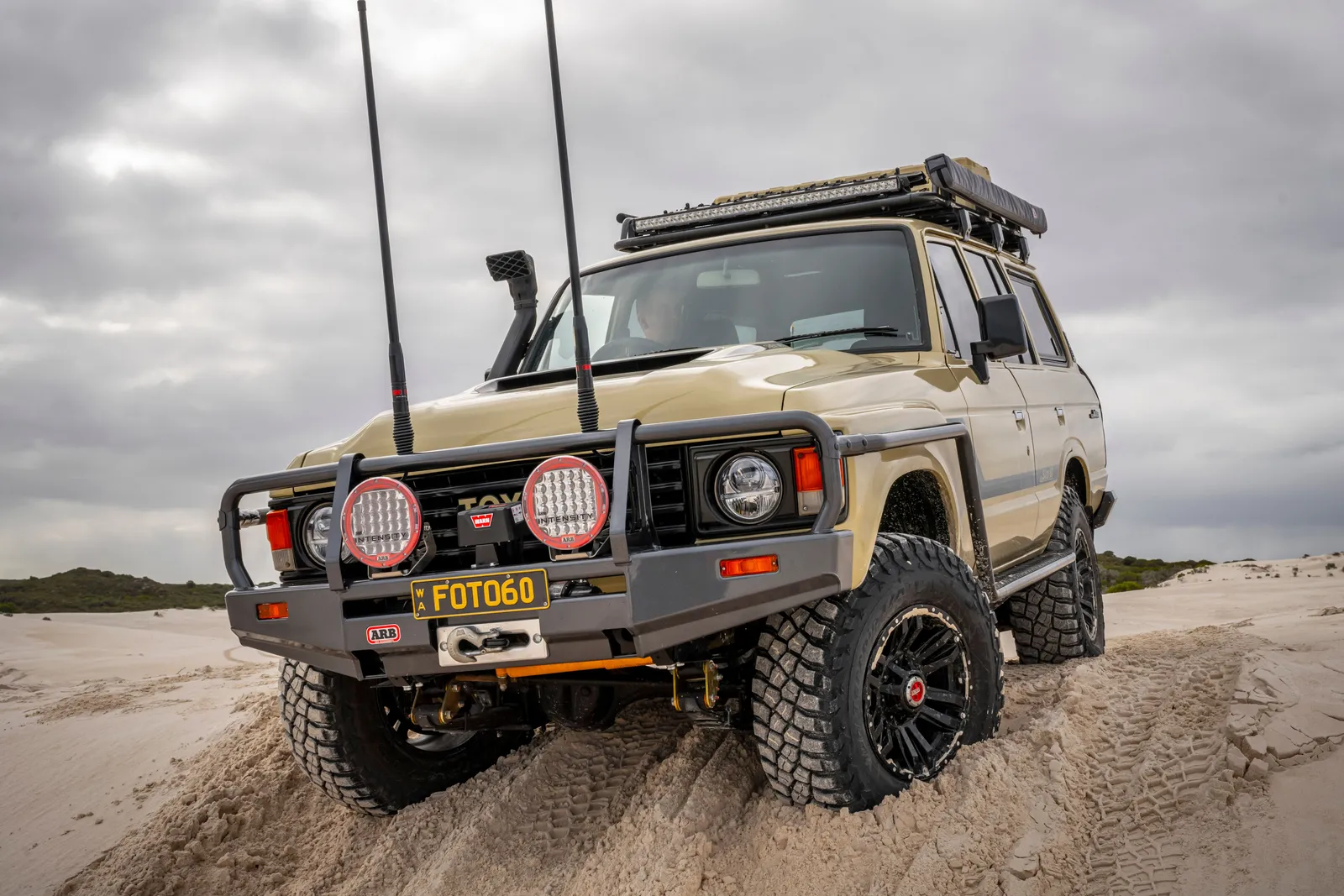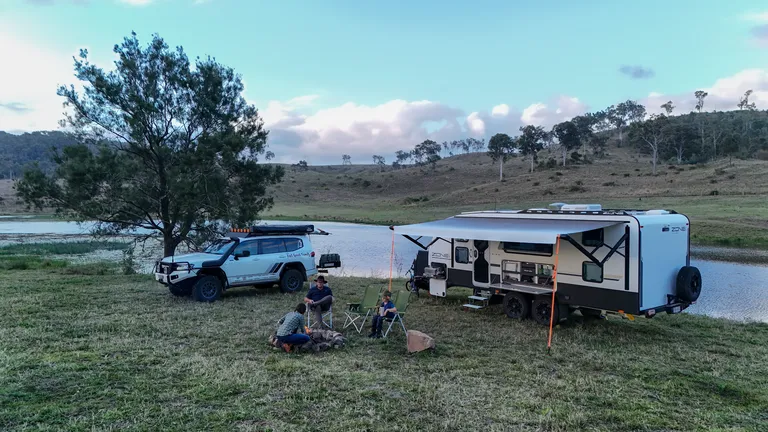After a trip to K’Gari to help clean up the island, we thought we should write a story to help people understand how to enjoy themselves while driving on sand.
Sand driving is a very different form of 4WDing and for many, it will be their preferred terrain to explore in their 4WD.
It can create an exciting experience and a great challenge, even for experienced drivers.
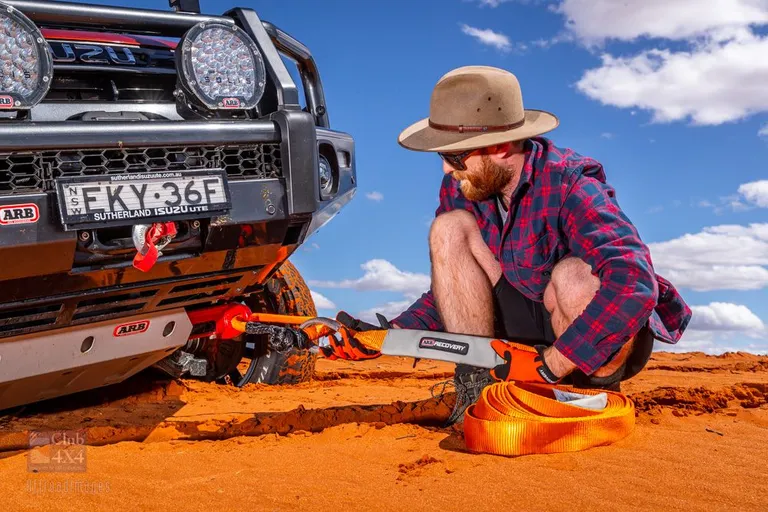
soft shackle 4wd recovery
Understanding how to prepare your 4WD, including tyre pressures and the general layout of the gear you carry, is crucial.
Even if you have driven on sand before, this article might be worth reading, as we will guide you through what gear to carry and how to prepare your vehicle.
Here are a few things worth considering:
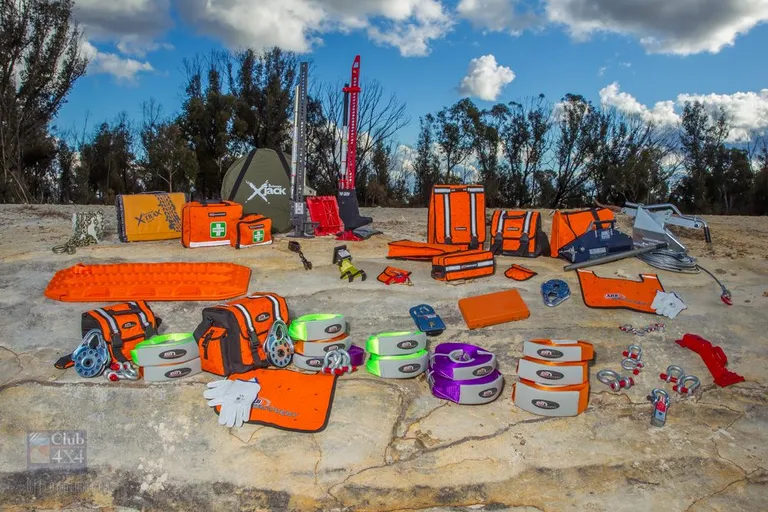
4wd recovery gear arb
Recovery Gear (snatch strap / soft or hard shackles / recovery boards)
At a minimum, everyone should carry a good quality snatch strap and soft or hard shackles to attach the strap to their vehicle. They should also understand how to use them, but even if they don't, having the gear means someone else might be able to assist in the event of becoming bogged.
Importantly, a snatch strap doesn’t always need to be used in a heavy snatch situation. It can be used for a low-impact recovery by slowly retrieving the bogged vehicle from the sand.
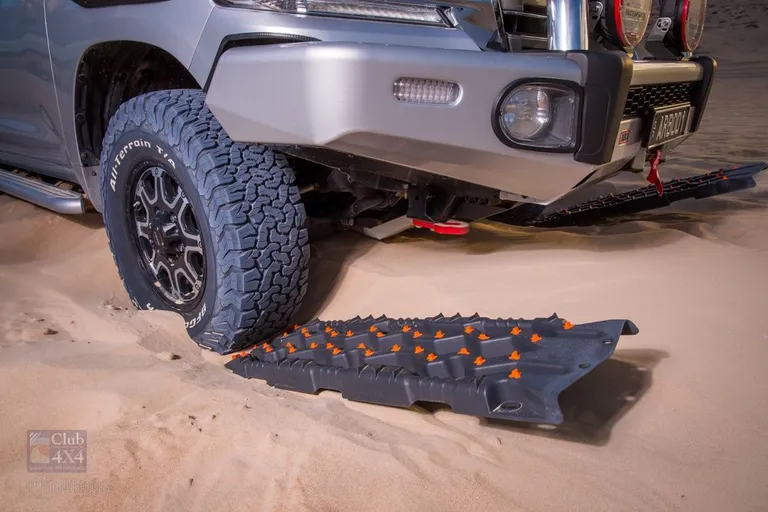
recovery board under 4wd sand driving
Recovery boards like Treds or MaxTrax can be essential for retrieving your vehicle without assistance. The bogged vehicle uses the recovery boards to help get out of the situation. These are great products, but you need to ensure you position the boards correctly under the tyres so they can grip and pull the boards into the tread pattern, lifting the vehicle out as it clears the bogging. Importantly, drive slowly on these boards and do not spin your tyres.
Remember, if you get stuck and there is no immediate danger, take your time and think about what you need to do to retrieve your vehicle so you can continue your journey.
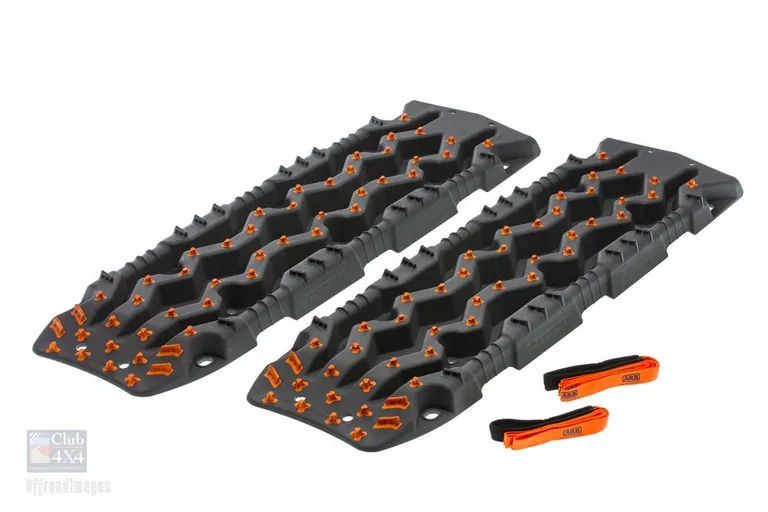
Jacking Plate and a Vehicle Jack
Trying to jack a vehicle up in soft sand is virtually impossible with just a jack, as the base might sink deep into the sand, rendering it useless and outright dangerous.
Using a jacking plate or a flat piece of timber helps spread the load over a larger surface area, ensuring the jack holds the vehicle up while changing a tyre. There are several products available on the market, but if you don’t have a jacking plate, try using the blade of a shovel under the jack to support it and spread the load.

jacking base plate
I purchased a length of solid yet lightweight pine and cut it into small rectangular sections. I overlap these sections to create a firm base under a jack in less stable environments like sand.
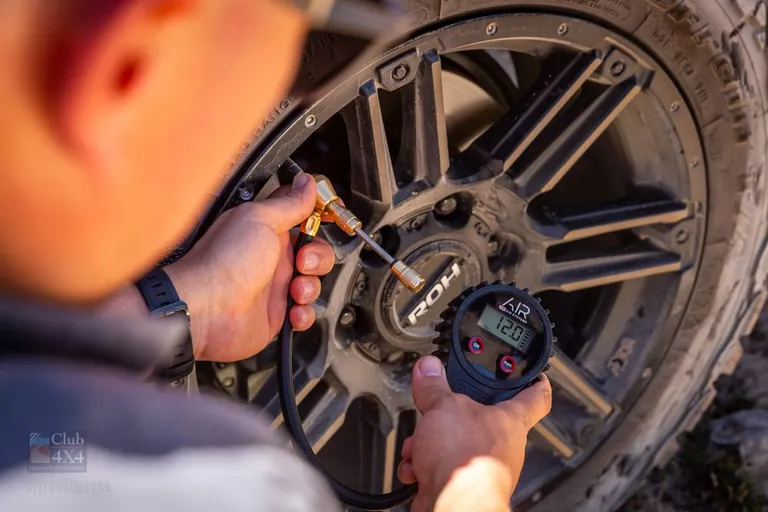
tyre deflator off-road
Tyre Deflator
A tyre deflator is one of the most important items you might carry on a 4WD trip. When heading to the beach, a tyre deflator can assist you in quickly and accurately airing down your tyres, which can also help if you become stuck in the sand. By reducing your tyre pressure a few PSI, you might be able to extract yourself from a bogged situation.
Tyre Pressure Gauge
An accurate tyre pressure gauge is essential for easily checking tyre pressures and ensuring you have a good understanding of the pressure you are running. Investing in a high-quality gauge ensures it's quick to use and, most importantly, accurate.
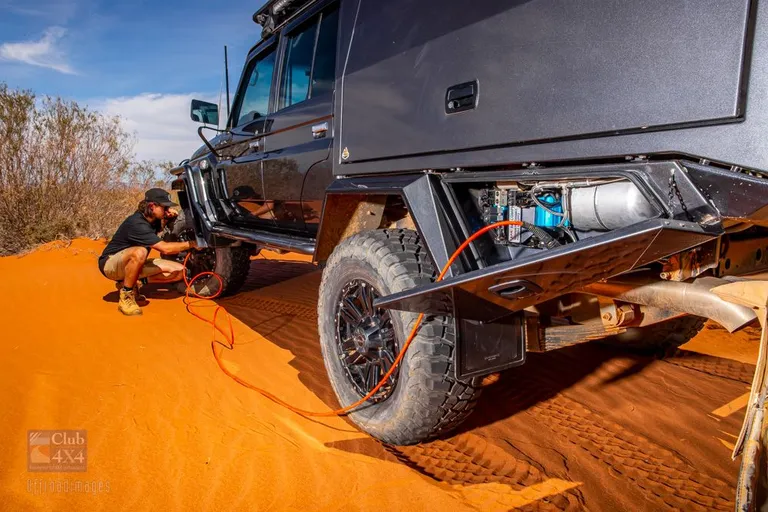
Air Compressor
Investing in a good quality air compressor is worth every cent. I've seen people underestimate the importance of a reliable air compressor. When a cheap $50 compressor fails, they struggle to increase tyre pressures when returning to firmer ground. This can be incredibly frustrating and jeopardize safe travels to the next location.

tyre repair kit
Tyre Repair Kit
I believe everyone should have a tyre repair kit as a standard item in their 4WD, either for personal use or to assist others in need. A tyre repair kit contains various items that can help get you out of trouble. For instance, it includes valve caps, which are often lost and can be replaced from the kit. Valves can sometimes malfunction due to sand or mud ingress and may require replacement; the kit typically contains a tool for removing and replacing them. Additionally, tyre punctures can be repaired using items from a tyre repair kit, among other uses.

shovel sand 4wd stuck on beach
Long-handled Shovel
There are many items that can assist you in recovering your own vehicle in the sand, but self-recovery can be greatly facilitated by simply digging your vehicle out. While you can use your hands for this task, a shovel will make a significant difference.
I recall recovering our 100 Series Cruiser on Stockton Beach sand dunes many years ago with the assistance of a plastic-covered clipboard.
The reason I recommend a long-handled shovel is to help you easily reach under the diffs and subframe of the vehicle. It can be challenging to access some of these hard-to-reach places with a short fold-up shovel.
Sand Flag
Sand flags aren't always required when driving in sand, but if you're heading to areas with dunes, they can significantly enhance safety. They provide a conspicuous item (the flag) high in the air above your vehicle, making it easier for approaching vehicles to see you.
Polarised Sunglasses
When driving on sandy terrain in the middle of the day, visibility can be extremely challenging. Polarized sunglasses, which reduce glare, can provide the driver with a clearer view of the terrain, enhancing safety during the trip.
Of course, essentials like water, sunscreen, and a hat are also crucial considerations.
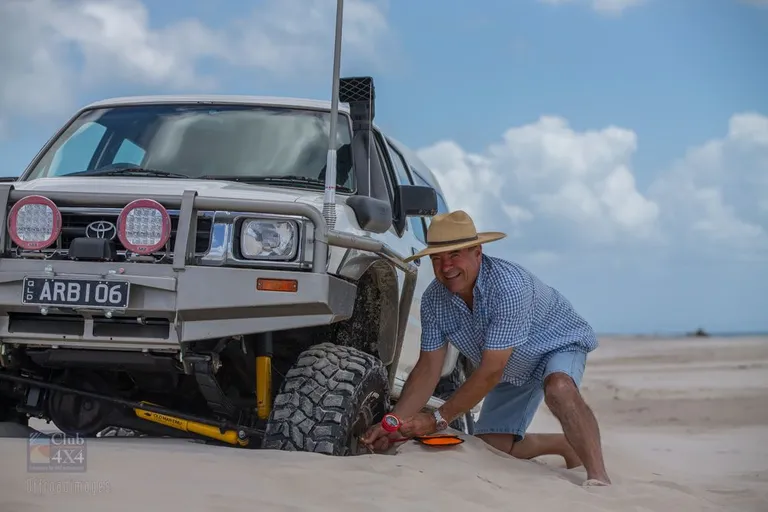
4wd recovery on the beach
Getting Onto The Sand Safely
Now that you have the important items packed in your vehicle, what do you do when you get to the sand?
If you're heading onto a beach where the sand is soft to walk on, it's important to understand the varying levels of sand firmness you might encounter, ranging from hard-packed surfaces that require no reduction of tyre pressures to soft sand that necessitates significant pressure adjustments.
From the West Coast to the East Coast of Australia, these levels can vary greatly. A good starting point is to speak with locals about the tyre pressures they typically use on a particular beach.
As a general rule, if your vehicle is struggling a bit in the sand, reducing your tyre pressures by 2 PSI can make a significant difference. For instance, if you're running at 20 PSI and you release 2 PSI from your tyres, that's a reduction of 10 percent, and you should notice an improvement. If necessary, continue to decrease pressure by another 2 PSI.
With experience, you'll become more adept at determining the ideal tyre pressures simply by assessing the sand conditions you're driving in.

toyota beach driving
Lower Tyre Pressures
Now that you've lowered your tyre pressures, it's crucial to drive with care. Lower pressures increase the risk of dislodging a tyre from the bead of the wheel, as the pressure holding the tyre to the rim has been reduced. Avoid sharp turns and exercise caution when crossing rutted tracks in the sand.
Consider The Environment.
The condition of the sand can vary depending on weather conditions. In hot and dry weather, the sand becomes softer, making driving more challenging. Conversely, colder temperatures and higher humidity make driving in the sand easier. After rainfall, driving on the beach becomes smoother.
Quicksand Does Exist.
In certain areas, sand saturated with water can resemble quicksand, particularly near long-standing water courses. While it's not common, it's worth keeping in mind to avoid parking in such areas.
Park on Sand Facing Downhill.
When parking on the beach, try to position your vehicle so that you can drive off downhill later. Parking on a slight uphill incline can make it more difficult to start driving again.
Be Aware of The Seventh Wave.
Although the concept of the seventh wave is a myth, waves can vary in intensity and reach further up the beach. Be mindful of where you park your vehicle to avoid being caught off guard by the sea.
Check the Tides and Weather.
Driving on beaches is a thrilling experience, but it's essential to check the tides and weather conditions. Take a tide chart specific to the area you'll be driving in, as conditions can vary between the East and West Coasts of islands like Moreton or Fraser Islands. Strong winds can also affect tide levels, potentially causing higher tides than predicted.
Be Aware of Your Fuel Usage.
Driving on sand increases fuel consumption due to the vehicle working harder at slower speeds. Plan for approximately a 50% increase in fuel usage to avoid running short. It's advisable to refuel before embarking on a few days of soft sand driving.
Enjoy Yourself.
Sand driving is a fantastic opportunity for fun and relaxation, as long as you're well-prepared. Bringing the right gear will boost your confidence, and being familiar with the environment ensures your safety.
And don't forget that when you return home, it's important to give your 4WD a thorough cleaning, perhaps even following our guide on How to Properly Clean Your 4WD.

recovering 4wd off beach
“Cheers”
Michael Ellem | Offroad Images
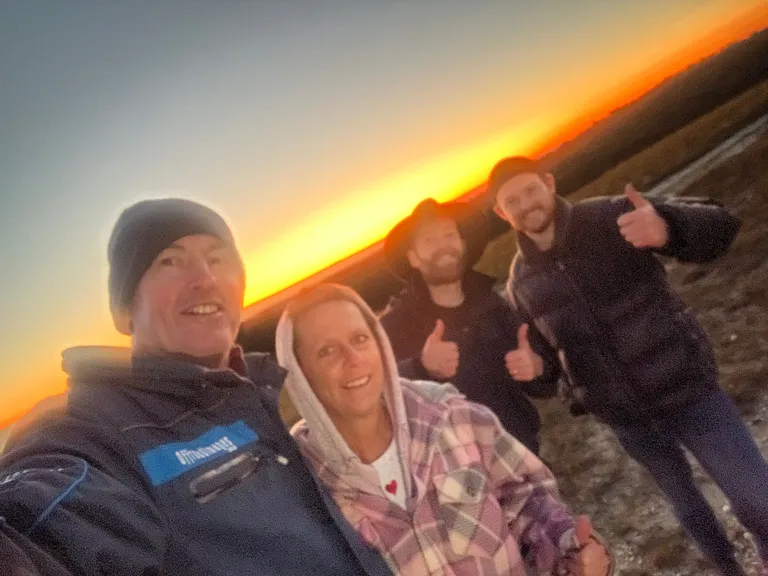
michael ellem offroad images
Want to use your 4WD for what it's really made for?
Our comprehensive insurance goes anywhere you're legally allowed to go, on-road and off.
The Campfire - Feedback
Just like sitting around the campfire, we would love to hear what you have to say.
Also… we will be featuring stories about photography tips and tricks, 4X4 preparation, build planning and maintenance, as well as featuring inspirational locations for you to visit in your 4X4. So please get involved and let us know what you’d like to hear about.
If you have any requests for stories to be featured in campfire or would like to provide feedback about this article, please send us a message on our social links…
Instagram: @offroadimages
Facebook: @offroadimages
YouTube: https://www.youtube.com/OffroadImages
Website: http://www.offroadimages.com.au
As 4X4 enthusiasts who live for the opportunity to create awesome imagery anywhere in Australia, we know that our vehicle assets are covered wherever we travel to create that shot, as we are insured by Club 4X4.


